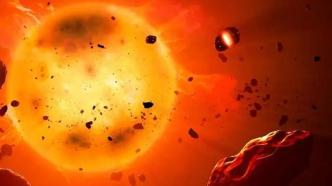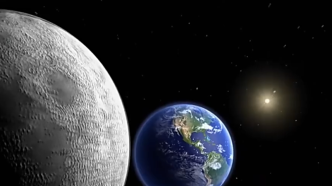
In the movie "The Wandering Earth", the reason why the earth wanders is because astronomers discover that the sun is rapidly aging and expanding, and will engulf the earth.
This is not just a bridge that only appears in science fiction movies. In fact, when the sun reaches the end of its life, it will indeed expand to 100 times its current size and eventually swallow the earth. Many planets in other galaxies will face similar doom as the stars they orbit age too.
But that doesn't mean there's no cure. Now, astronomers at the University of Hawaii Institute for Astronomy (UH-IfA) see hope in a surviving planet that should have died at the hands of its star.
This "lucky guy" is the Jupiter-like planet Halla, which orbits the red giant star Baekdu. The distance between them is only half of the distance from the earth to the sun.
Halla was discovered in 2015 by Korean astronomers using the radial velocity method. Due to the gravitational pull of orbiting planets, stars will produce periodic motion, and the existence of planets can be determined by this method. At the time, researchers discovered that Halla orbited a star that was once larger than a planet's orbit.
A team led by NASA Hubble Scholar Marc Hon of UH-IfA, using the Keck Observatory on the island of Hawaii and the Canada-France-Hawaii Telescope, found that although the evolution of Baekdu is usually dangerous, Halla is still tenacious. .
Using NASA's Transiting Exoplanet Survey Satellite (TESS), they observed Baekdu's stellar oscillations and found that the star's core was burning helium, suggesting that it once expanded into a red giant. The star may have expanded to 1.5 times the planet's orbital distance, swallowed the planet in the process, and then shrunk to its current size, which is only 1/10 of the previous distance. Related research was published in Nature on June 28.
"Such engulfment would be catastrophic for the planet or the star itself. The fact that Halla managed to survive near a giant star that would otherwise engulf it underscores its extraordinary nature," said Hon, lead author of the study.
So, how exactly did Halla survive? In this regard, the researchers have three conjectures.
The first conjecture is that Halla, like other Jupiter-like planets, orbits in a larger orbit before migrating inwards closer to its star. Even so, Halla is hardly immune to a rapidly aging and expanding star.
A second guess is that Halla may not have been in danger of being swallowed in the first place. Similar to Tatooine, which orbits a binary star system in Star Wars, Halla's orbiting Baekdu may have originally been a binary star system consisting of two stars as well. And the merger of the two stars may have prevented either star from expanding enough to engulf Halla.
A third hypothesis is that Halla is a newborn planet, born of a violent collision between two stars. In other words, Halla may be a second-generation planet that was born only recently.
"Most stars are in binary star systems, but we don't yet fully grasp how planets form around them. There may be more surviving planets around swell-evolving stars due to binary star interactions," Hon said. (Original title "Resurrected from the Dead, Scientists Discover a Planet That Shouldn't "Exist"")
Related paper information:
https://doi.org/10.1038/s41586-023-06029-0


